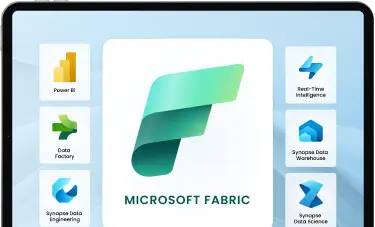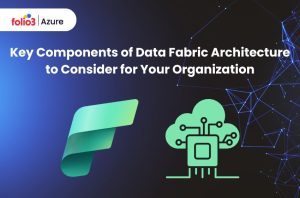Table of Contents
ToggleAre you hustling to perfect your data management strategy? Then implementing Medallion Lakehouse Architecture in Microsoft Fabric is an excellent and powerful solution for you. This architecture not only simplifies data processing but also guarantees scalability and high efficiency. By employing Fabric with medallion architecture, you can maneuver your data more effectively, and transform it from raw data to valuable information.
The medallion architecture layers provide a structured approach to data management, letting you tackle various data types and transformations easily. Microsoft Fabric setup facilitates flexible and quick data processing, making it easier to implement and maintain a cloud-based data architecture. In this blog, we will root out how you can utilize this architecture to enhance your data workflows.
Accelerate smart decisions with Microsoft Fabric's unified data and AI analytics.

What is Medallion Lakehouse Architecture?
Medallion Lakehouse Architecture is a data management strategy that organizes data into different layers, each serving a specific purpose. This structure includes Bronze, Silver, and Gold layers, enabling efficient data processing and management.
- Bronze Layer: This is the raw data ingestion layer. Data is ingested in its original form, making it available for initial processing.
- Silver Layer: Here, data is cleansed and enriched. The data in this layer is more refined and ready for more analysis.
- Gold Layer: This layer contains aggregated, business-ready data that is further improved for reporting and decision-making.
The core benefits of using a Lakehouse architecture include improved data quality, better data governance, and increased scalability in data management. By taking advantage of data lakehouse architecture, you can manage your data lifecycle more efficiently. This architecture also supports different data ingestion techniques, facilitating flexibility in how data is brought into the system.
Key Components of Medallion Architecture
An in-depth understanding of the Medallion architecture layers is mandatory for its effective implementation, so let’s dig deeper into the Medallion Architecture.
1. Bronze Layer: Raw Data Ingestion
In the Bronze layer, raw data is ingested using various data ingestion strategies. This layer serves as the base for all later data processing stages. By storing raw data in Microsoft Fabric, you ensure that the data is easily available for initial processing and transformation. This layer can handle high-volume data flow and enables scalability in data management.
2. Silver Layer: Cleansed and Enriched Data
The Silver layer is where data cleansing and enrichment takes place via various processes. By employing tools provided by Microsoft Fabric, you can transform raw data into a more usable form. This consists of removing duplicates, rectifying errors, and enriching the data with additional information. The target of this layer is to prepare the data for detailed analysis. Data transformation processes in this layer are mandatory for ensuring data quality and consistency.
3. Gold Layer: Aggregated, Business-Ready Data
The Gold layer focuses on data aggregation and summarization. Here, data is refined into business-ready datasets that can be used for reporting and decision-making. Creating business-ready datasets in Microsoft Fabric consists of utilizing advanced data transformation and aggregation techniques. This layer ensures that data is presented in a format that is easy to interpret and can be used for strategic decision-making.
Advantages of Using Microsoft Fabric for Data Architecture
Microsoft Fabric offers a multitude of advantages for implementing a cloud-based data architecture:
1. Scalability
Microsoft Fabric provides strong options for scalability. It allows you to handle large volumes of data efficiently and easily.
2. Security
By utilizing the built-in security features, you can ensure data privacy and compliance with regulations.
3. Ease of Use
Microsoft Fabric’s user-friendly interface makes it accessible to users with different levels of technical expertise.
4. Integration Capabilities
Microsoft Fabric supports the integration of data from different data sources, enabling easy data ingestion and processing.
These features make Microsoft Fabric stand out and a perfect choice for implementing Medallion Lakehouse Architecture. The platform’s flexibility and scalability suit a vast array of data management requirements, from small-scale projects to large enterprise solutions.
Accelerate smart decisions with Microsoft Fabric's unified data and AI analytics.

Implementing Medallion Lakehouse Architecture in Microsoft Fabric
Follow the steps below to successfully and smoothly implement Medallion Lakehouse Architecture in Microsoft Fabric.
1. Setting Up Your Environment
Prerequisites for Implementing the Architecture
Make sure you have all the requirements ready before you begin. This involves configuring your Microsoft Fabric setup and ensuring you have all the necessary access, permissions, and resources. Proper configuration is a must for achieving maximum performance and scalability in data management.
Configuring Microsoft Fabric for Optimal Performance
Configure your Microsoft Fabric setup to maximize performance. This stage consists of refining settings to efficiently handle data ingestion, transformation, and storage. By improving your configuration, you can ensure that your data workflows are simplified and that the system performs well under different loads.
2. Bronze Layer Implementation
Data Ingestion Techniques
To load raw data into the Bronze layer, use various data ingestion techniques. Microsoft Fabric supports multiple ingestion strategies, including batch processing and real-time streaming. Selecting the proper ingestion technique depends on your data sources and requirements.
Storing Raw Data in Microsoft Fabric
Store the ingested raw data in Microsoft Fabric, making sure that it is easily available for further processing in the Silver layer. Proper storage management is mandatory for maintaining data integrity and accessibility.
3. Silver Layer Implementation
Data Cleansing and Transformation Processes
In the Silver layer, cleanse and transform the raw data. This consists of removing duplicates, correcting errors, and enriching the data with additional data. Use Microsoft Fabric tools to automate and simplify these processes. Excellent data transformation is the base for guaranteeing that the data is ready for analysis and reporting.
Using Microsoft Fabric Tools for Data Enrichment
Fully utilize Microsoft Fabric tools to boost the data enrichment process. These tools provide functionalities for transforming and enriching data easily and efficiently, ensuring that your data is accurate, complete, and ready for further analysis.
4. Gold Layer Implementation
Data Aggregation and Summarization
In the Gold layer, compile and summarize the cleansed data. This involves creating business-ready datasets that are ready and can be used for reporting and analysis. Data aggregation techniques help in combining data from different sources and presenting it in a usable format.
Creating Business-Ready Datasets and Reports
Use Microsoft Fabric to create detailed datasets and reports. These datasets should be refined for business use and provide valuable information for decision-making. The ability to generate accurate and timely reports is the backbone of long-term planning and achieving operational efficiency.
Best Practices for Implementation
It is highly recommended to follow these best practices to ensure the successful implementation of Medallion Lakehouse Architecture in Microsoft Fabric:
1. Data Governance and Security
Ensuring Data Privacy and Compliance
Strong data governance measures, including encryption and data masking, are necessary to guarantee data privacy and regulatory compliance. Protecting data privacy also ensures meeting all legal requirements and builds trust.
Role-Based Access Control and Data Masking
Implement role-based access control to restrict data access based on user roles. Data masking techniques can additionally strengthen data security. These practices help in safeguarding sensitive data and ensuring that only authorized users have access to it.
2. Optimization Techniques
Performance Tuning for Large-Scale Data
Tuning various parameters enhances the performance of your data architecture. This includes optimizing queries, indexing data, and managing resources efficiently. Performance tuning ensures that your system can handle large-scale data easily and give quick responses.
Cost Management and Resource Allocation
Manage your costs by keeping a close eye on resource usage and allocating resources optimally. Microsoft Fabric equips you with strong tools for tracking and managing costs. Effective cost management helps maximize the value of your investment and ensure that resources are used efficiently.
3. Monitoring and Maintenance
Tools and Techniques for Monitoring the Architecture
Employ monitoring tools to trace the performance and health of your data architecture. These tools can help spot issues and guarantee smooth operation. Periodic monitoring is needed to maintain system performance and prevent possible problems.
Regular Maintenance Tasks and Best Practices
To maintain the best possible state of your data architecture, carry out routine maintenance. This covers regular checks, updates, and adjustments. Frequent maintenance guarantees the long-term dependability and peak efficiency of your system.
Conclusion
Implementing Medallion Lakehouse Architecture in Microsoft Fabric provides a scalable, secure, and efficient data management solution. By organizing data into Bronze, Silver, and Gold layers, you can simplify and enhance your data processing and ensure high-quality, business-ready information. Following best practices for implementation and taking advantage of Microsoft Fabric’s features will assist you achieve the best performance and data governance.
For more information on data management solutions and how Microsoft Fabric can enhance your data architecture, visit us at Azure Data Analytics.
Establishing your business as a pioneer in data architecture solutions can help you attract and retain customers who are searching for reliable, safe, and scalable data management solutions. In order to achieve this goal and make sure your data management approach is successful and future-proof, you must implement Medallion Lakehouse Architecture in Microsoft Fabric. This way, you can maintain your competitive edge in the data management environment by fully utilizing the potential of cloud-based data architecture.


